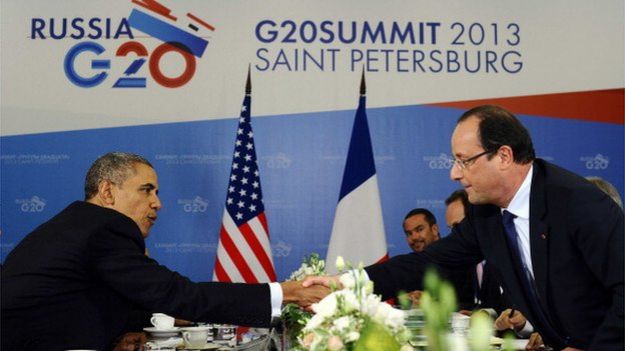Every day the possibility of the US and France leading military action against Syria edges closer. If it happens, it will mark another twist in a long and complex relationship.
Barack Obama and Francois Hollande were the only two leaders at the G20 meeting in Moscow committed to using force against Syria.
They make a pretty unexpected coalition of the willing, when you remember the American anti-French backlash over Iraq a decade ago, when french fries were off the menu and French wine down the plug-hole.
But the image of the two presidents with fortunes entwined provides a neat historical symmetry. After all, if it wasn't for France then George Washington might today only be a name known to avid history students.
In 1778, a fledgling nation called the United States made its first alliance, an event that many experts believe altered the course of its war of independence with Britain.
The treaty signed by Francophile Benjamin Franklin in Paris meant France recognised the United States as a sovereign nation and was committed to the defence of its new ally. In effect, it brought France into the war against its long-standing enemy, Britain.
"It was the first formal alliance for the US, this treaty of alliance and friendship and it probably made the difference between victory and defeat," says Gregory Urwin, a professor of history at Temple University in Philadelphia.
"They were already providing covert aid, shipping weapons and munitions to Americans though front trading companies, but once they entered the war it changed the entire dynamic because Britain could no longer count on mastery of the sea."
Every American is taught about the famous victory at Yorktown and the heroics of a dashing Frenchman, the Marquis de Lafayette, the young idealist who joined the Americans before his country had even entered the war.
But it's another Frenchman, the Count of Rochambeau, who is the real French hero, says Urwin, because as commander of the French forces he had a decisive influence on Washington's triumph at Yorktown.
The friendship between the two nations didn't last long. France expected American assistance in the wars that followed the French Revolution but Washington was reluctant to get drawn into a European conflict in the 1790s and chose neutrality, ignoring the terms of the treaty and sparking a quasi-war with France.
But the mythology of Lafayette was set in stone in 1824 when the park adjoining the White House on its northern side was renamed Lafayette Square, in a city designed by another Frenchman, Pierre L'Enfant.
Lafayette was further immortalised in World War I when, on American Independence Day in 1917, US troops paraded through Paris and stopped at his tomb, where at his request he was buried in soil brought from the US. The shouts of "Lafayette, we are here!" symbolised a country repaying its debt 140 years later.
By then, the Statue of Liberty was already fast becoming one of New York City's most visible landmarks. It was a gift from "the French people" in 1886 that expressed the two countries' shared values.
The second world war of the 20th Century offered another chance for American soldiers to be warmly welcomed on French soil. In Normandy, the Stars and Stripes can still be seen fluttering from homes on the anniversary of the D-Day landings.

没有评论:
发表评论